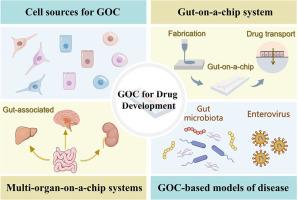Emerging microfluidic gut-on-a-chip systems for drug development
IF 9.4
1区 医学
Q1 ENGINEERING, BIOMEDICAL
引用次数: 0
Abstract
The gut is a vital organ that is central to the absorption and metabolic processing of orally administered drugs. While there have been many models developed with the goal of studying the absorption of drugs in the gut, these models fail to adequately recapitulate the diverse, complex gastrointestinal microenvironment. The recent emergence of microfluidic organ-on-a-chip technologies has provided a novel means of modeling the gut, yielding radical new insights into the structure of the gut and the mechanisms through which it shapes disease, with key implications for biomedical developmental efforts. Such organ-on-a-chip technologies have been demonstrated to exhibit greater cost-effectiveness, fewer ethical concerns, and a better ability to address inter-species differences in traditional animal models in the context of drug development. The present review offers an overview of recent developments in the reconstruction of gut structure and function in vitro using microfluidic gut-on-a-chip (GOC) systems, together with a discussion of the potential applications of these platforms in the context of drug development and the challenges and future prospects associated with this technology.
Statement of significance
This paper outlines the characteristics of the different cell types most frequently used to construct microfluidic gut-on-a-chip models and the microfluidic devices employed for the study of drug absorption. And the applications of gut-related multichip coupling and disease modelling in the context of drug development is systematically reviewed. With the detailed summarization of microfluidic chip-based gut models and discussion of the prospective directions for practical application, this review will provide insights to the innovative design and application of microfluidic gut-on-a-chip for drug development.

用于药物开发的新兴微流控芯片肠道系统。
肠道是口服药物吸收和代谢处理的重要器官。虽然已经开发了许多以研究肠道药物吸收为目标的模型,但这些模型未能充分再现多样、复杂的胃肠道微环境。最近出现的微流控芯片器官技术为肠道建模提供了一种新的手段,使人们对肠道结构及其影响疾病的机制有了全新的认识,对生物医学发展工作产生了重要影响。此类芯片器官技术已被证明具有更高的成本效益、更少的伦理问题,而且在药物开发方面能更好地应对传统动物模型的物种间差异。本综述概述了使用微流控芯片肠道(GOC)系统在体外重建肠道结构和功能的最新进展,并讨论了这些平台在药物开发中的潜在应用以及与该技术相关的挑战和未来前景。意义说明:本文概述了最常用于构建微流控芯片肠道模型的不同细胞类型的特征,以及用于药物吸收研究的微流控装置。并系统回顾了与肠道相关的多芯片耦合和疾病建模在药物开发中的应用。本综述详细总结了基于微流控芯片的肠道模型,并讨论了实际应用的前瞻性方向,将为药物开发中微流控芯片肠道的创新设计和应用提供启示。
本文章由计算机程序翻译,如有差异,请以英文原文为准。
求助全文
约1分钟内获得全文
求助全文
来源期刊

Acta Biomaterialia
工程技术-材料科学:生物材料
CiteScore
16.80
自引率
3.10%
发文量
776
审稿时长
30 days
期刊介绍:
Acta Biomaterialia is a monthly peer-reviewed scientific journal published by Elsevier. The journal was established in January 2005. The editor-in-chief is W.R. Wagner (University of Pittsburgh). The journal covers research in biomaterials science, including the interrelationship of biomaterial structure and function from macroscale to nanoscale. Topical coverage includes biomedical and biocompatible materials.
 求助内容:
求助内容: 应助结果提醒方式:
应助结果提醒方式:


